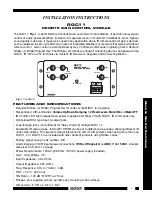
D
IP
S
WITCH
S
ETTINGS
C
ONTINUED
...
DIP SWITCH 6: INDEPENDENT PLC AND RELAY CONTROL
This dip switch allows for power line carrier control of devices independent of the relay circuits.
FACTORY DEFAULT SETTING = OFF
Off = Relay circuits will be controlled at the same time as the PLC transmitter controlled devices. The
relays are coupled with the “P” input terminal.
On = Relay circuits can be controlled separate from the PLC transmitter controlled devices. The relays
are coupled with the “E” input terminal.
The CCRP is also capable of providing independent control of some of its relays separate
from each other. This feature is used in applications where multiple load control strate-
gies are being utilized. For more information on how to enable independent relay control,
refer to Note 7 in the Notes section of this manual.
DIP SWITCH 7: Negative Outdoor Temperature Calibration
This dip switch is used to calibrate the outdoor temperature sensor information downward if it is reading higher
than the actual outdoor temperature. In most situations, this procedure does not need to be performed.
FACTORY DEFAULT SETTING = OFF
Off = Standard operating position.
On = A negative 5
o
F (-5
o
F) outdoor temperature calibration is applied.
DIP SWITCH 8: Positive Outdoor Temperature Calibration
This dip switch is used to calibrate the outdoor temperature sensor information upward if it is reading lower
than the actual outdoor temperature. In most situations, this procedure does not need to be performed.
FACTORY DEFAULT SETTING = OFF
Off = Standard operating position.
On = A positive 5
o
F (+5
o
F) outdoor temperature calibration is applied.
TESTING PLC COMMUNICATION
(If using the built-in PLC Transmitter Feature for Control)
The PLC system is a highly accurate and reliable method of control. Communications between the transmitter
and a correlating receiver occur on regular basis. It may take up to seven (7) minutes for the transmitter to
establish initial communication, depending on the speed of the channel selected and the noise level on the electrical
systems. Subsequent communications will occur more rapidly. In the 1000 and/or 2000 series heater, the lower
right indicator light on their face plate will illuminate green continuously once the heater begins to retrieve good
signal. In the mini receiver device, the red indicator light on its circuit board will illuminate continuously once it is
receiving complete information. In the 2100, 3100, 4100, 5100, 6100, 7100, 8100, and 9100 series systems, access
the Help Menu to verify power line carrier communication.
If NOT utilizing the automatic charge control feature of the CCRP, a 4300 ohm resistor
must be placed between the two OS terminals to prevent the 2100, 3100, 4100, 5100, 6100,
7100, 8100 or 9100 Series heating system(s) from displaying Error 6 (Er 06).
Comfort Control Relay Panel (CCRP)
Page 7
































